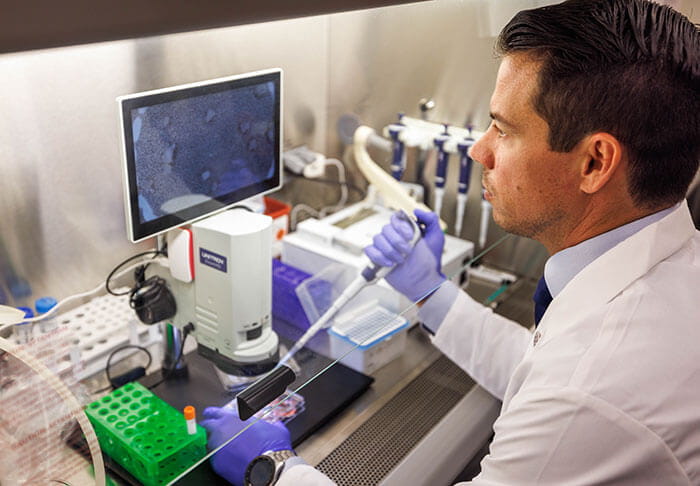UH Seidman Researcher Parlaying Findings in Nature into More Effective Immunotherapy for Brain Tumors, Targeting Myeloid Cells
July 21, 2025
Innovations in Cancer
A major impediment to the successful use of immunotherapy in glioblastoma is the preponderance of a type of immune cell in the tumor, called myeloid cells, which can make up as much as 50% of all cells in the tumor. It’s thought that these myeloid cells create an immunosuppressive environment, making it difficult for immunotherapy treatments to reach their cancer cell targets.
 Tyler Miller, MD, PhD
Tyler Miller, MD, PhDTo circumvent this process, much more must be understood about how myeloid cells actually function inside the tumor, says Tyler Miller, MD, PhD, pathologist and glioblastoma researcher at UH Seidman Cancer Center. And he’s leading an effort to do just that.
“As a field, we have studied these tumors a lot,” he says. “We know that not only are myeloid cells not attacking the cancer cells themselves, which in theory they should, they are turning around and also preventing the rest of the immune system from attacking the cancer. What we don’t know is how, or why, they do this, or how we can target them to reduce the immunosuppression in these tumors.”
However, through the work of Dr. Miller and colleagues, we now know considerably more. Using the latest single cell genomics technology and advanced organoid modeling, the research team has discovered that there are four activity programs that myeloid cells share – no matter their cell type, whether it be the native microglia that reside normally in the brain, or macrophages, monocytes, dendritic cells or neutrophils the come from the peripheral blood. The team published its findings in the journal Nature.
This discovery has real-world, clinical applications, Dr. Miller says.
“Our analytical methods allowed us to pull out information that other people had not been able to see before,” he says. “It was those four different activities that dictated how the patient responded to immunotherapy, the patient’s overall survival, and the overall immune state of the tumor. It was really these four activities that were the main drivers of all the different clinical factors that we looked at -- and not the myeloid cell types, which was how these cells had previously been studied. The four activities we discovered were largely invisible to people before, because of the way people typically analyze their data.”
The four activities delineated include: systemic inflammatory, microglial inflammatory, complement immunosuppressive and scavenger immunosuppressive.
“We think one of those is pretty good, microglial inflammatory, the two immunosuppressive program are certainly bad, and maybe even the systemic inflammatory one is not great,” Dr. Miller says. “So the question becomes: How do we either get rid of the myeloid cells that are expressing a ‘bad’ activity, or reprogram them to start expressing the activity that we think is good? How do we modify the myeloid cell population to reprogram the overall immune state of the tumor to one that is responsive to immunotherapy?”
To accomplish this, Dr. Miller and his team are looking to launch an ambitious “moonshot” project to target myeloid cells with CAR T-cells. The idea of targeting myeloid in solid tumors is not new, he says. However, using the Nature findings and CAR T technology to more specifically target a myeloid cells expressing a certain activity would be a novel approach.
 Caption: Ty Miller, MD, PhD is looking to target myeloid cells with CAR T-cells so that brain tumors are responsive to immunotherapy at the Wesley Center for Immunotherapy at UH Seidman Cancer Center.
Caption: Ty Miller, MD, PhD is looking to target myeloid cells with CAR T-cells so that brain tumors are responsive to immunotherapy at the Wesley Center for Immunotherapy at UH Seidman Cancer Center.“Many people have thought about how to reprogram or target myeloid cells,” he says. “People have used a lot of small molecules, which tend not to be very specific, or they tend to try to remove all the myeloid cells instead of just the subpopulation that is expressing a certain activity. We’ve learned that getting rid of all the myeloid cells doesn’t work. You need to have myeloid cells there to have an effective immune response. You just need to have the right ones.”
Brain tumors, including glioblastoma, are a promising venue for trying this new approach, Dr. Miller says. CAR T-cells can be safely delivered directly into the brain and have been shown to shrink tumors in the short term. However, myeloid cells suppress the CAR T-cells, leading to tumor relapse. This is where targeting myeloid cells could help enable durable response.
“CAR T-cells seemingly wipe out the entire tumor in many cases, but that response isn't sustained,” he says. “Here the idea would be to use CAR T-cells to target the cancer cells while simultaneously targeting the exact right myeloid cells and see if we can fine-tune the microenvironment to enable durable responses for patients.”
Contributing Expert:
Tyler Miller, MD, PhD
Pathologist, UH Seidman Cancer Center
Clinical Assistant Professor, Pathology
Case Western Reserve University School of Medicine


